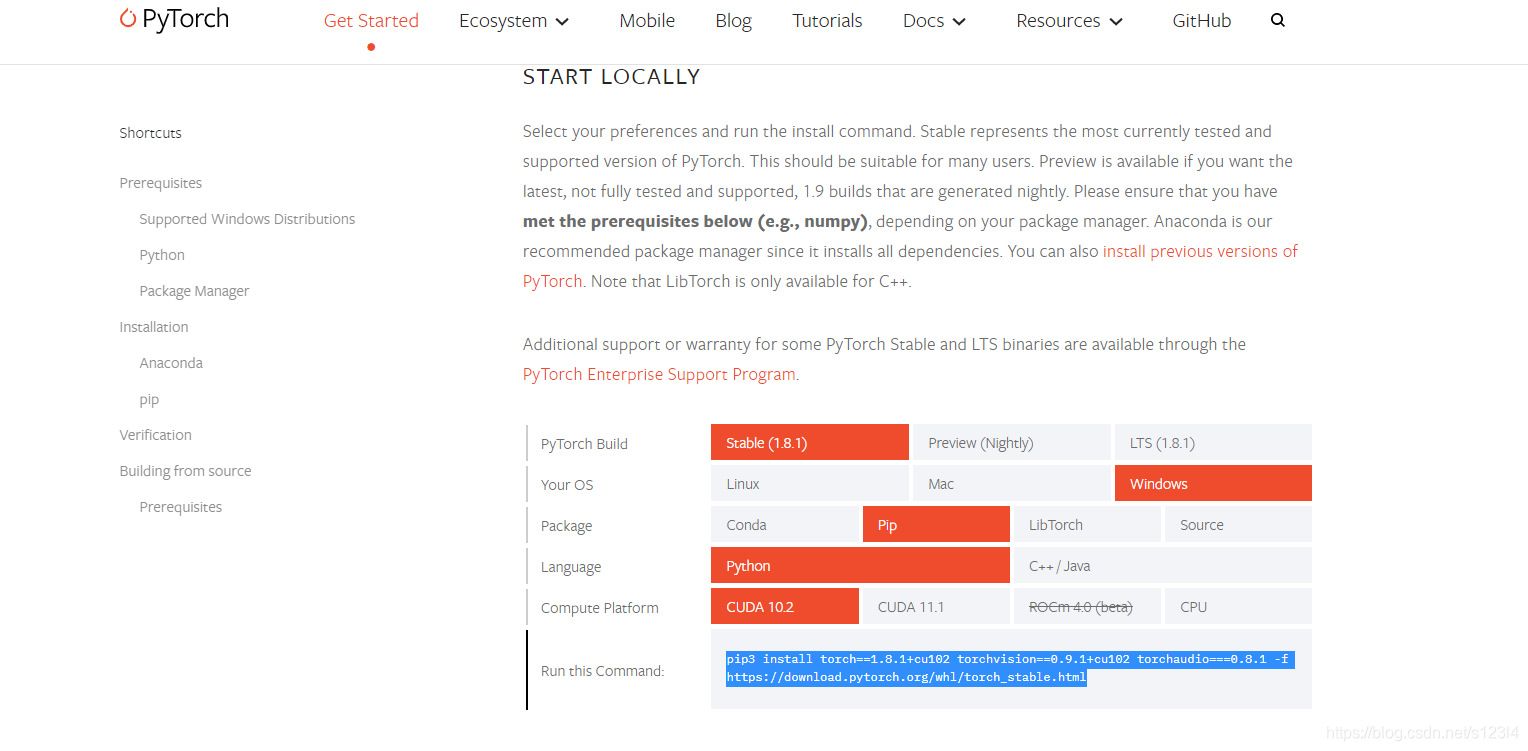vue+flask实现视频目标检测yolov5
本文共 5998 字,大约阅读时间需要 19 分钟。
开始做这个之前,了解一些vue的基础,然后对flask完全不知道。所以特别感谢很多博主的文章。
主要参考的是这篇文章:,博主在GitHub上详细的代码给我一个很好的参考,他采用的是前后端分离开发的方式。 一.前端搭建 参考视频: 参考博客:vue-cli2.9.6+ElementUI搭建。(首先要安装node)
1.搭建脚手架:npm install -g vue-cli@2.9.6 2.创建一个基于webpack模板的项目vue init webpack 自定义项目名 3.运行项目npm run dev 二.后端搭建 主要是yolov5环境的一个搭建。 参考博客:(1),介绍了如何安装与删除虚拟环境
(2),我的配置就是根据这个来的。1.首先是虚拟环境的配置(最好是在虚拟环境中搭建,血与泪的教训),conda create -n torch107 python=3.7
activate torch107 3.安装pytorch,首先已经安装anaconda3,yolov5需要pytorch1.6以上,pip3 install torch==1.8.1+cu102 torchvision==0.9.1+cu102 torchaudio===0.8.1 -f https://download.pytorch.org/whl/torch_stable.html 4.下载源码和安装环境依赖 源码指路: 安装依赖库:
4.下载源码和安装环境依赖 源码指路: 安装依赖库:pip install -r requirements.txt,txt文件内容如下: # pip install -r requirements.txt# base ----------------------------------------matplotlib>=3.2.2numpy>=1.18.5opencv-python>=4.1.2PillowPyYAML>=5.3.1scipy>=1.4.1torch>=1.7.0torchvision>=0.8.1tqdm>=4.41.0# logging -------------------------------------tensorboard>=2.4.1# wandb# plotting ------------------------------------seaborn>=0.11.0pandas# export --------------------------------------# coremltools>=4.1# onnx>=1.9.0# scikit-learn==0.19.2 # for coreml quantization# extras --------------------------------------# Cython # for pycocotools https://github.com/cocodataset/cocoapi/issues/172pycocotools>=2.0 # COCO mAPthop # FLOPS computation
三.yolov5检测视频
参考视频:,时间25:36以后 我的代码: 检测代码Detect.py:import torchimport numpy as npfrom models.experimental import attempt_loadfrom utils.general import non_max_suppression, scale_coords, letterboxfrom utils.torch_utils import select_deviceimport cv2from random import randintclass VideoCamera(object): def __init__(self): # 通过opencv获取实时视频流 self.img_size = 640 self.threshold = 0.4 self.max_frame = 160 self.video = cv2.VideoCapture("E:/videodata/1.mp4") #换成自己的视频文件 self.weights = 'weights/final.pt' #yolov5权重文件 self.device = '0' if torch.cuda.is_available() else 'cpu' self.device = select_device(self.device) model = attempt_load(self.weights, map_location=self.device) model.to(self.device).eval() model.half() # torch.save(model, 'test.pt') self.m = model self.names = model.module.names if hasattr( model, 'module') else model.names self.colors = [ (randint(0, 255), randint(0, 255), randint(0, 255)) for _ in self.names ] def __del__(self): self.video.release() def get_frame(self): ret, frame = self.video.read() #读视频 im0, img = self.preprocess(frame) #转到处理函数 pred = self.m(img, augment=False)[0] #输入到模型 pred = pred.float() pred = non_max_suppression(pred, self.threshold, 0.3) pred_boxes = [] image_info = { } count = 0 for det in pred: if det is not None and len(det): det[:, :4] = scale_coords( img.shape[2:], det[:, :4], im0.shape).round() for *x, conf, cls_id in det: lbl = self.names[int(cls_id)] x1, y1 = int(x[0]), int(x[1]) x2, y2 = int(x[2]), int(x[3]) pred_boxes.append( (x1, y1, x2, y2, lbl, conf)) count += 1 key = '{}-{:02}'.format(lbl, count) image_info[key] = ['{}×{}'.format( x2 - x1, y2 - y1), np.round(float(conf), 3)] frame = self.plot_bboxes(frame, pred_boxes) # 因为opencv读取的图片并非jpeg格式,因此要用motion JPEG模式需要先将图片转码成jpg格式图片 ret, jpeg = cv2.imencode('.jpg', frame) return jpeg.tobytes() def preprocess(self, img): img0 = img.copy() img = letterbox(img, new_shape=self.img_size)[0] img = img[:, :, ::-1].transpose(2, 0, 1) img = np.ascontiguousarray(img) img = torch.from_numpy(img).to(self.device) img = img.half() # 半精度 img /= 255.0 # 图像归一化 if img.ndimension() == 3: img = img.unsqueeze(0) return img0, img def plot_bboxes(self, image, bboxes, line_thickness=None): tl = line_thickness or round( 0.002 * (image.shape[0] + image.shape[1]) / 2) + 1 # line/font thickness for (x1, y1, x2, y2, cls_id, conf) in bboxes: color = self.colors[self.names.index(cls_id)] c1, c2 = (x1, y1), (x2, y2) cv2.rectangle(image, c1, c2, color, thickness=tl, lineType=cv2.LINE_AA) tf = max(tl - 1, 1) # font thickness t_size = cv2.getTextSize( cls_id, 0, fontScale=tl / 3, thickness=tf)[0] c2 = c1[0] + t_size[0], c1[1] - t_size[1] - 3 cv2.rectangle(image, c1, c2, color, -1, cv2.LINE_AA) # filled cv2.putText(image, '{}-{:.2f} '.format(cls_id, conf), (c1[0], c1[1] - 2), 0, tl / 3, [225, 255, 255], thickness=tf, lineType=cv2.LINE_AA) return image app.py代码:
from flask import *import cv2import logging as rel_logfrom datetime import timedeltafrom flask_cors import CORSfrom Detect import VideoCameraapp = Flask(__name__)cors = CORS(app, resources={ r"/getMsg": { "origins": "*"}}) #解决跨域问题,vue请求数据时能用上@app.route('/')def index(): return render_template('index.html') #template文件夹下的index.htmldef gen(camera): while True: frame = camera.get_frame() # 使用generator函数输出视频流, 每次请求输出的content类型是image/jpeg yield (b'--frame\r\n' b'Content-Type: image/jpeg\r\n\r\n' + frame + b'\r\n\r\n')@app.route('/video_feed') # 这个地址返回视频流响应def video_feed(): return Response(gen(VideoCamera()), mimetype='multipart/x-mixed-replace; boundary=frame')if __name__ == "__main__": app.run(host='127.0.0.1', port=5000, debug=True) index.html:
视频检测 linjie
 }})
运行后端python app.py
response = { 'image_url': 'http://127.0.0.1:5000/video_feed' },但总觉得哪里不妥。。。 转载地址:http://ierfi.baihongyu.com/
你可能感兴趣的文章
消息队列设计精要
查看>>
分布式存储系统设计(1)—— 系统架构
查看>>
MySQL数据库的高可用方案总结
查看>>
常用排序算法总结(一) 比较算法总结
查看>>
SSH原理与运用
查看>>
SIGN UP BEC2
查看>>
出现( linker command failed with exit code 1)错误总结
查看>>
iOS开发中一些常见的并行处理
查看>>
iOS获取手机的Mac地址
查看>>
ios7.1发布企业证书测试包的问题
查看>>
如何自定义iOS中的控件
查看>>
iOS 开发百问
查看>>
Mac环境下svn的使用
查看>>
github简单使用教程
查看>>
如何高效利用GitHub
查看>>
环境分支-git版本管理
查看>>
fhs-framework jetcache 缓存维护之自动清除缓存
查看>>
ZUUL2 使用场景
查看>>
Spring AOP + Redis + 注解实现redis 分布式锁
查看>>
支付宝生活号服务号 用户信息获取 oauth2 登录对接 springboot java
查看>>